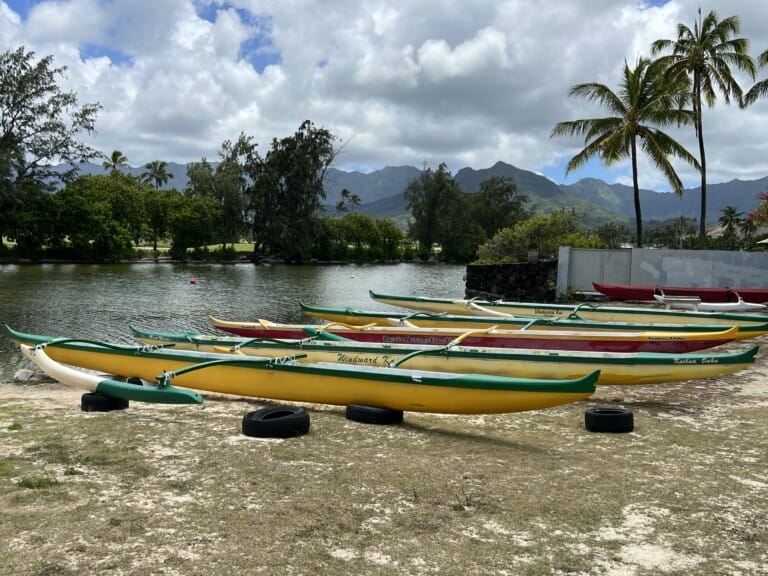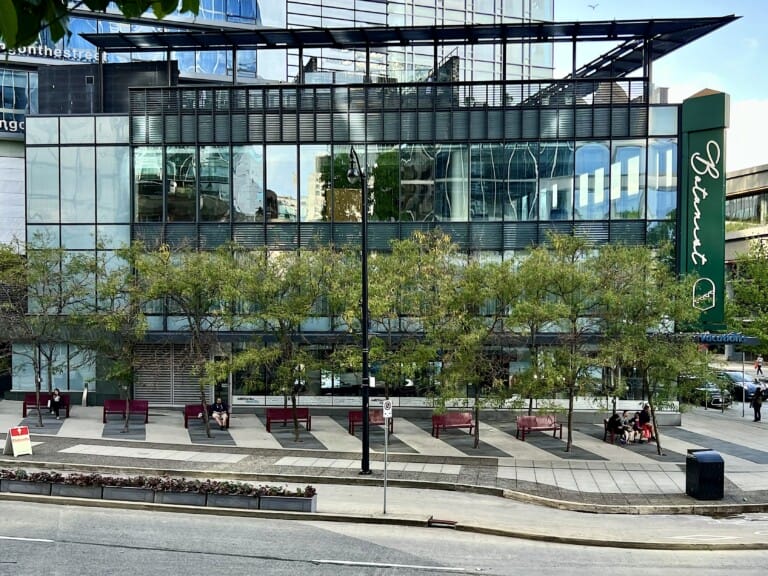Not every culinary stop has to involve mass intake of food and drink. Sometimes it’s necessary to take a breather, find some perspective and actually re-build a full appetite. On my most recent trip to Vancouver, Pacific Institute of Culinary Arts initiated an educational respite as PICA executive chef Julian Bond led me and a group of media types on a tour of sprawling Granville Island Market, featuring an introduction to “locally impassioned artisans, farmers and food purveyors.”
We started at PICA, which opened 15 years ago and faces False Creek. Publications like the LA Times have debated the merits of culinary school versus on-the-job training, and despite their obvious allegiance, PICA President Sue Singer and Tim Allison – in-house sommelier and certified chef – were candid. Allison touted the benefits of culinary school, saying, “It creates community and builds contacts around the world.” He also pointed out that graduation doesn’t entitle chefs to instant celebrity, quoting another instructor who added, “When you graduate, you earn the right to carry a bucket. And for the rest of your life, you try to fill it.”
During our school tour, we saw students in action in the kitchen and pastry kitchen, which helps to feed an on-site bakery and resident cafe where advanced students prepare lunch for customers. As Allison said, “Chefs tend to get a puffy idea of their own importance, so we drag them out…connect with the guest, remind them of their existence.” PICA also offers wine and business training.
Granville Island originally housed a paper and siding company, which arrived in the 1880s, along with a train line. Granville Island still houses a bunch of these original buildings, but Granville Bridge moved.
Our mic’d up, whirlwind walk with British born Chef Bond was indicative of the type of tour that’s normally available through PICA every day but Sunday, as long as at least four people are willing to invade Granville Island. He started on the bridge by discussing Ocean Wise, a sustainability initiative that the Vancouver Aquarium patterned after Monterey Bay Aquarium’s Seafood Watch, which rates seafoods either green, yellow or red. He pointed out the Organic Ocean boat and Captain Steve, which shows up daily at 1:30 p.m. for six weeks in the spring at “Public Fish Sales” dock, selling prizes spot prawns. Chef Bond surprised each tourgoer with ha single spot prawn, which he bought prior to the tour, cooked for 45 and dressed with citrus and Dijon vinaigrette on the spot. It was great, so sweet.
Our first stop on the island was at The Lobster Man, a seafood market with open-topped tanks of seafood, including the namesake lobster. We learned it takes seven years to grow lobster to 1.5 pounds. Also, in lobster’s less glamorous days, at Kingston prison on Canada’s East Coast, prisoners got so tired of eating the now-prized crustacean that they declared a hunger strike. Bond suggested ripping off the arms and legs and cooking separately. Otherwise it’s easy to overcook the lobster appendages. When presentation doesn’t matter – like it lobster pasta, Bond suggested asking for “cull lobsters,” which cost less and taste just as sweet, but have a bite taken out of the tail or are missing legs.
Chef Bond provided a quick overview of Pacific Northwest oysters. The Lobster Man charged $1.40 per Kusshi and $1.10 per Large Beach oyster. Bond called that value for money, but reminded tourgoers the Beach oyster is not designed for raw consumption, but barbecued them, and the Beach opens naturally. In generally, Kusshis and Kumamotos are sweeter. Thus the price difference.
Chef Bond said to be aware about the reality of “fresh” Sockeye salmon. It’s typically 6-8 days out of the water by the time it hits supermarket shelves. It’s gutted, bled and flash frozen before rigor mortis sets in. Defrost and it’s a 12-hour fish, a better product and you can’t tell the difference, said Bond.
Chef Bond shared the story of Bruno from Finest at Sea, who owns three commercial fishing boats. It costs him $7 million per year to catch cod, so they have to recoup costs. He decided to catch only what he could sell, in exchange from guarantees from the seafood industry on what he catches, so he’s not compelled to overfish, and he could point to specific boats and fishermen when selling the product. He smokes and preserves the surplus, which leads to hot smoked sardines, smoked teriyaki sablefish candy and whiskey smoked white spring salmon
“When it comes to Roma tomatoes, if they all look identical, don’t buy them,” said Bond. He surprised me with his preference for canned tomatoes from Italy, but explained why. He said supermarket tomatoes are usually picked and transported green, then ripened in a fridge for 2-3 days with ethylene gas. As he said, “Real flavor is in the vine,” and in the can, even from Italy, that flavor remains. Later in the tour, talk once again turned to produce. Chef Bond said, “If you’re going to buy one thing organic in the market, it should be celery…” It’s one of the most easily contaminated vegetables, because their root system soaks up water, good and bad.
Bond provided another fun lesson about perceived value. He said Portobello mushrooms were so plentiful that farmers fed them to pigs because they were overgrown. However, somebody decided to market them under a new name and charge twice as much. Then they hit.
Chef Bond wasn’t down on every supermarket product, saying, “Apples are the things you should buy from the market.” He also approved that you can normally find 6-8 types and they typically cost about the same price, which encourages variety and education.
At Dussa’s Ham & Cheese, we learned about how to store and present blue cheese. As Chef Bond said, people don’t like blue cheese because it’s wrapped in plastic and smells brutal. Wrap in cheese cloth or unwrap and let it breathe. He said, “I guarantee it tastes different.”
Blue cheese wasn’t the only topic of cheese conversation. So was Camembert. Chef Bond said, “The only difference between Camembert and Brie is approximately 200 kilometers.” Camembert has stronger flavor, and it’s larger, with more evaporation. Another fun fact: Camembert and Brie are both looking to take back the names, like Champagne.
We passed by Siegel’s Bagels, which makes fresh bagels throughout the day, and visited Oyama Sausage Co., home to fifth generation sausage and prosciutto makers. As Chef Bond said, “They believe the pig should die without stress,” so they’re slaughtered individually.
Chef Bond said that Canada is the biggest exporter of horse meat, and he explained the rationale behind eating them to Americans. Horses live a long time and cost a lot of money to feed. If they weren’t kept on pasture, the owners would let horses starve to death, but as meat, there’s a humane incentive to keep them alive and healthy.
Chef Bond seamlessly alternated between discussing food politics and fun food products. Our horse meat conversation segued to the Stock Market, a cleverly named booth that specializes in the essence of cooking. As Chef Bond said, “A stock pot is not a garbage can. The only thing that should go in it is bones and mire poix.” At PICA, veal stock cooks for three full days, free of flour, thickening or coloring agents. For people without that kind of patience, the Stock Market fills an important culinary need.
We took a brief respite outside to enjoy the flavors of the market on a sensory level. Chef Bond constructed a simple but delicious snack of Oyama prosciutto, Quallicum brie and Vista d’oro Turkish fig and walnut wine preserves, with figs aged six months in brandy from the Okanagan, B.C.’s wine producing region.
South China Seas Trading Co. sold hard to find products (for Vancouver) like habanero peppers, nopales, green peppercorns, lime leaf, young ginger and fiddleheads, all featuring accompanying cards with suggested uses. Ginger is apparently best peeled with a spoon.
Chef Bond left us with one final recommendation at Tenderland Meats, saying that when cooking leg of lamb, remove fat from the middle – the thyroid – and you’ll get milder flavor after roasting,
The information in this article accounts for only a small part of what we learned from Chef Bond on the tour. This tour would probably work even better for locals, since Vancouverites could actually apply Chef Bond’s advice on a regular basis. Still, a good amount of his education could easily apply in other markets. Also, proceeds benefit PICA and the culinary school curriculum, which would probably be a bonus for culinary school proponents.
PICA’s plugged-in tour normally runs from 10 a.m. – 11:30 a.m., costs $40 per person and includes a complimentary coffee/tea, pastry and PICA canvas tote bag.
Note: My culinary tour was complimentary, as part of a tour that Tourism Vancouver hosted.





Leave a Comment